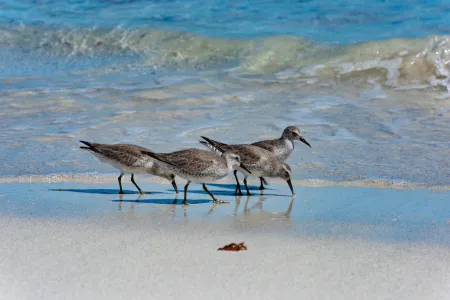The more we learn about the movements of animals around the globe, the more extraordinary it seems. But migratory species are among the most vulnerable of the world’s creatures because they rely on sympathetic management of not just a single place where they live out their lives but multiple places, with their numbers controlled by conditions at the place where life is most difficult. For international migrants, life is especially difficult because countries assert ownership of animals on both sides of a border but rarely recognise that other countries also have legitimate interests in the same individuals. We have worked for many years with animal movements with a developing interest in policy given a close connection to the Convention on Migratory Species.
Meet the team
- Barry Baker
- David Drynan
- Stephen Garnett
- Marcus Haward
Publications
Morrick, Z. N., Lilleyman, A., Fuller, R. A., Bush, R., Coleman, J. T., Garnett, S. T., ... & Woodworth, B. K. 2022. Differential population trends align with migratory connectivity in an endangered shorebird Conservation Science and Practice 4(1): e594. https://doi.org/10.1111/csp2.594
Galtbalt, B., Lilleyman, A., Coleman, J. T., Cheng, C., Ma, z., Rogers, D. I., Woodworth, B. K., Fuller, R. A., Garnett, S. T., Klaassen, M. 2021. Correction to: Far eastern curlew and whimbrel prefer flying low - wind support and good visibility appear only secondary factors in determining migratory flight altitude Movement Ecology 9(1): 32. https://doi.org/10.1186/s40462-021-00289-z
Jackson, M. V., Woodworth, B. K., Bush, R., Clemens,R. S., Fuller, R. A., Garnett, S.T., Lilleyman, A., Maron, M., Purnell, C., Rogers, D. I., Amano, T. 2021. Widespread use of artificial habitats by shorebirds in Australia Emu 121(3): 44835. https://doi.org/10.1080/01584197.2021.1873704
Lilleyman, A., Rogers, D. I., Jackson, M. V., Fuller, R. A., & O'Brien, G., et al. 2020. An artificial site provides valuable additional habitat to migratory shorebirds in a tropical harbour Pacific Conservation Biology, 26(3): 249--257. https://doi.org/10.1071/PC19036
Lilleyman, A., Alley, A., Jackson, D., O’Brien, G. and Garnett, S.T. 2018. Distribution and abundance of migratory shorebirds in Darwin Harbour, Northern Territory, Australia. Northern Territory Naturalist 28: 30-42.
Runge, C.A., Gallo‐Cajiao, E., Carey, M.J., Garnett, S.T., Fuller, R.A. and McCormack, P.C. 2017. Coordinating domestic legislation and international agreements to conserve migratory species: A case study from Australia Conservation Letters 10: 765-772. https://doi.org/10.1111/conl.12345
Garnett, S.T., Sutton, P., Lowe, K.W. and Gray, S. 1990. Land bird migration across Bass Strait, autumn 1988. Corella 15: 1-7.
Garnett, S.T. 1985. Mortality and group cohesion in migrating Rainbow Bee‑eaters. Emu 85: 267-268. https://doi.org/10.1071/mu9850267
Garnett, S.T. and Minton, C.D.T. 1985. Notes on the movements and distribution of the Little Curlew Numenius minutus in northern Australia. Australian Bird Watcher 11: 69-73.
Garnett, S.T. 1983. Report on the fifth aerial survey of migrating wading birds between Weipa and Milingimbi, 9‑13 February 1983. Stilt 4: 15-17.
Robert N. van Zalinge, Jeb Barzen and Stephen T. Garnett. 2023. Spatial modeling of Sarus Crane nest site suitability in Cambodia to help target conservation of breeding areas Forest Ecology and Management 529: . https://doi.org/10.1016/j.foreco.2022.120703
Robert N. van Zalinge, Jeb Barzen and Stephen T. Garnett. 2023. Tracking sarus crane movements in Cambodia and Vietnam reveals seasonal vulnerabilities and gaps in protected area coverage Endangered Species Research 50: 151-165. https://doi.org/10.3354/esr01227
Nevard T. D., Franklin D. C., Leiper I., Archibald G. and Garnett S. T. 2019. Agriculture, brolgas and Australian sarus cranes on the Atherton Tablelands, Australia Pacific Conservation Biology 25: 377-385. https://doi.org/10.1071/PC18081
Nevard T. D., Leiper I., Archibald G. and Garnett S. T. 2019. Farming and cranes on the Atherton Tablelands, Australia Pacific Conservation Biology 25: 184-192. https://doi.org/10.1071/PC18055
Nevard, T., Haase, M., Archibald, G., Leiper, I., & Garnett, S. 2019. The sarolga: Conservation implications of genetic and visual evidence for hybridization between the brolga Antigone rubicunda and the Australian sarus crane Antigone antigone gillae Oryx 54(1): 40 - 51. https://doi.org/10.1017/S003060531800073X
Garnett, S.T. and Shephard, S. 1997. Cape York Peninsula, Australia, as a stopover site for Latham's Snipe Gallinago hardwickii. Stilt 30: 54-55.
Bell, M., Shield, J. and Garnett, S.T. 1995. Japanese Encephalitis in Australia: wildlife considerations. Communicable Diseases Intelligence 19: 647-648.
Garnett, S.T. and Flanagan, M. 1989. Survey for Newcastle Disease in northern Queensland birds. Australian Veterinary Journal 66: 129-134. https://doi.org/10.1111/j.1751-0813.1989.tb09777.x
Garnett, S.T., Draffan, R.D.W., Hindmarsh, R.W.H. and Williams, A.C. 1988. Booby Island. Corella 12: 69-71. https://doi.org/10.1071/WR9870521
Garnett, S.T. 1987. Aerial surveys of waders (Aves: Charadriiformes) along the coast of north‑eastern Australia. Australian Wildlife Research 14: 521-528. https://doi.org/10.1071/WR9870521
Garnett, S.T. 1987. Feather‑clipping: a Nauruan technique for short‑term recognition of individual birds. Corella 11: 30-31.
Draffan, R.D.W., Garnett, S.T. and Malone, G.J. 1983. Birds of the Torres Strait: an annotated list and biogeographical analysis. Emu 83: 207-232. https://doi.org/10.1071/MU9830207
Garnett, S.T. and Carruthers, I.B. 1982. Error in aerial surveys of wading birds. Stilt 3: 5-8.
Guard, R. and Garnett, S.T. 1982. Report on the first aerial survey of waders in N.E.Australia, December 1981. Stilt 3: 16-17.
Garnett, S.T. and Carruthers, I.B. 1982. Report on the second aerial survey of waders in N.E.Australia, February 1982. Stilt 3: 18-20.
